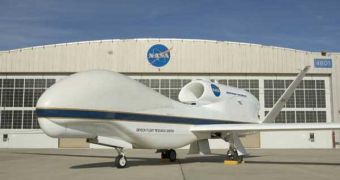Experts at the American space agency, who are currently conducting a detailed investigation of what makes tropical storms tick, say that their work is made incredibly easy by an unmanned air drone.
NASA is operating a Global Hawk unmanned aerial vehicle (UAV), which is generally used by the military for surveillance, espionage and air-to-ground attacks.
But scientists with the agency have removed all military equipment from their Hawk, and installed instead a large suite of scientific instruments, all of them destined to study atmospheric events.
Given the fact that it's unmanned, the aircraft is especially suited for dangerous flights, such as for instance right into the eye of approaching hurricanes and tropical storms.
“It's a game-changer. We've been able to get to storms that would otherwise be difficult to get to, and been able to spend a lot more time over the storms than would be possible with conventional aircraft,” explains NASA scientist Scott Braun.
He is a part of the team managing the Genesis and Rapid Intensification Processes (GRIP) experiment, and is based at the NASA Dryden Research Flight Center, at the Edwards Air Force Base (EAFB), in California.
The scientist told OurAmazingPlanet that the Global Hawk flew no less then 11 sorties above the center of tropical storm Mathew on September 23. The storm had developed virtually overnight.
The airplane is not completely autonomous. It is controlled from the safety of an operations room by seasoned US Air Force pilots.
The system can however take care of itself. “Once I push the takeoff button and push execute, the airplane could take off, fly 25 hours, come back and land. I could go home,” says pilot Dee Porter.
"You watch these scientists and they're just giddy, they're like kids on Christmas morning. It's a challenge, the team we've got here is just tremendous,” the pilot adds.
“I wake up every morning and I can't wait to get to work. Literally. I wake up early and I'll lie there and toss and turn until I can get up and get ready. I love coming to work,” Porter goes on to say.
Pilots of UAV always take control when their aircraft fly into storms. All that is need to control this expensive pieces of technology are four 21-inch monitors, a mouse and a keyboard.

 14 DAY TRIAL //
14 DAY TRIAL //